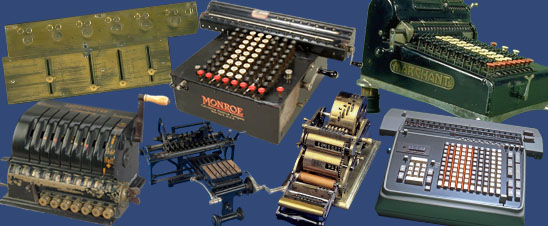This is the U.S. Patent Office model for a lever-set non-printing barrel-type calculating machine patented by George B. Grant of Maplewood, Massachusetts on August 16, 1887. It represents an improvement on machines Grant had patented July 16,1872 (U.S.
- Description
-
This is the U.S. Patent Office model for a lever-set non-printing barrel-type calculating machine patented by George B. Grant of Maplewood, Massachusetts on August 16, 1887. It represents an improvement on machines Grant had patented July 16,1872 (U.S. Patent 129,335) and April 29, 1873 (U.S. Patent 138245), and on the machine he exhibited at the Centennial Exhibition in Philadelphia in 1876.
-
The model has a rectangular wooden base. The frame is made up of two plates at either end of the base connected by metal shafts. The mechanism has a large upper cylinder and a small lower cylinder linked by gears of equal size. Fifteen centimeters (6”) of the upper cylinder has a metal collar that can be set at any of eight positions on the cylinder. This collar supports eight movable rings, each of which represents a digit entered. Each ring has an adding pin and a stud on it that may be set at any of 10 positions, labeled by the digits from 0 to 9.
-
The lower cylinder has ten recording wheels on it, each provided with 30 teeth. Paper loops numbered from 0 to 9 three times run around each wheel. On a bar between the cylinders is a row of ten spring claws, one for each recording wheel. If a claw is pushed down, it engages the gear of the recording wheel, causing it to rotate. Studs on the wheel lead to carrying by engaging the next claw over.
-
The model has no mechanism for displaying the multiplier or multiplicand.
-
This object was collected by L. Leland Locke and displayed at the Museums of the Peaceful Arts in New York City before coming to the Smithsonian.
-
George B. Grant (1849–1917) was born in Maine, studied for three terms at the Chandler Scientific School of Dartmouth College, and entered the Lawrence Scientific School of Harvard University in 1869, graduating in 1873. As an undergraduate, he became interested in computing devices, publishing an article on a new form of difference engine in 1871. During this time, he also took out two patents for calculating machines. Grant’s study of computing devices also led him to take a great interest in improved gears. He formed a total of five gear works in various American cities, and wrote treatises on the subject.
-
For a related object, see MA.310645.
-
According to L. Leland Locke, the models for Grant’s first two calculating machine patents were not preserved.
-
References:
-
George B. Grant, “Improvement in Calculating Machines,” U.S. Patent 138245 (April 29, 1873).
-
George B. Grant, “On a New Difference Engine,” American Journal of Science, ser. 3, vol. 2 (August 1871), pp. 113–117.
-
George B. Grant, “A New Calculating Machine,” American Journal of Science, ser. 3, vol. 8 (1874), pp. 277–284.
-
L. Leland Locke, “George Barnard Grant,” Dictionary of American Biography, vol. 7, New York: Scribners, 1931, pp. 487–488.
-
Robert K. Otnes, “Calculators by George B. Grant,” Historische Buerowelt, no. 19, October 1987, pp. 15–17.
-
George B. Grant, “Calculating-Machine,” U. S. Patent 368528 (August 16, 1887).
- Location
-
Currently not on view
- date made
-
1887
- inventor
-
Grant, George B.
- maker
-
Grant, George B.
- ID Number
-
MA.311940
- catalog number
-
311940
- accession number
-
155183
